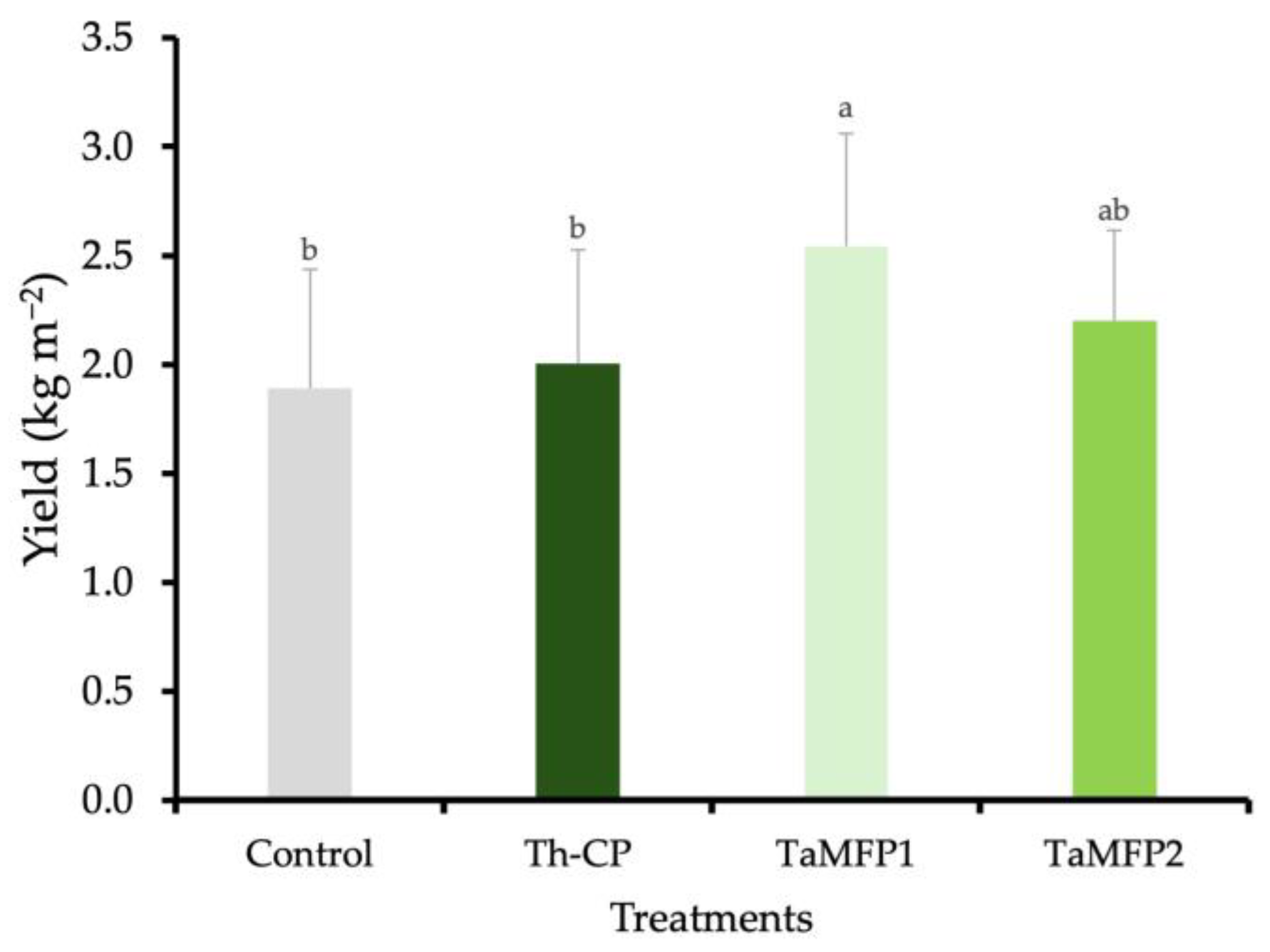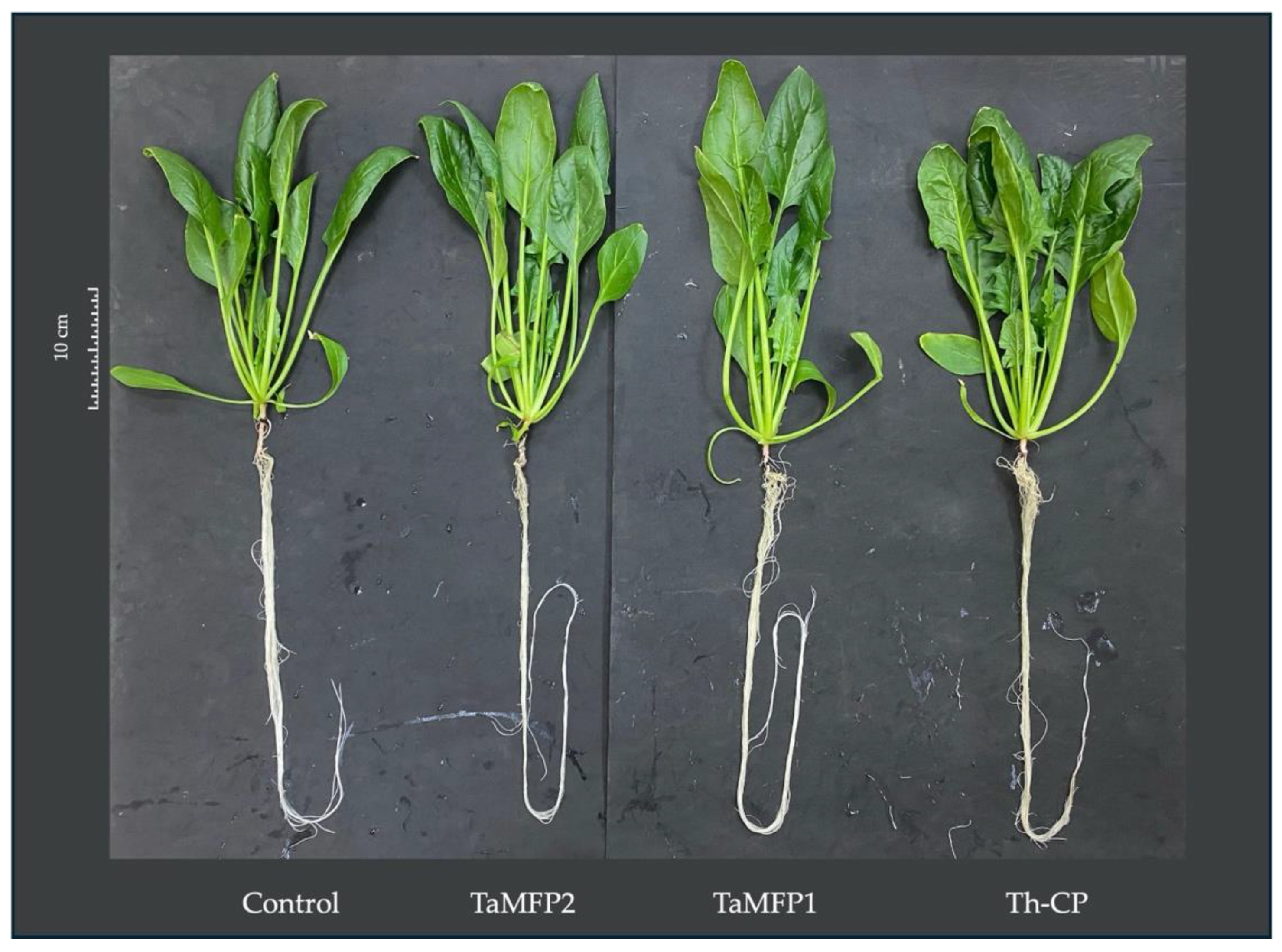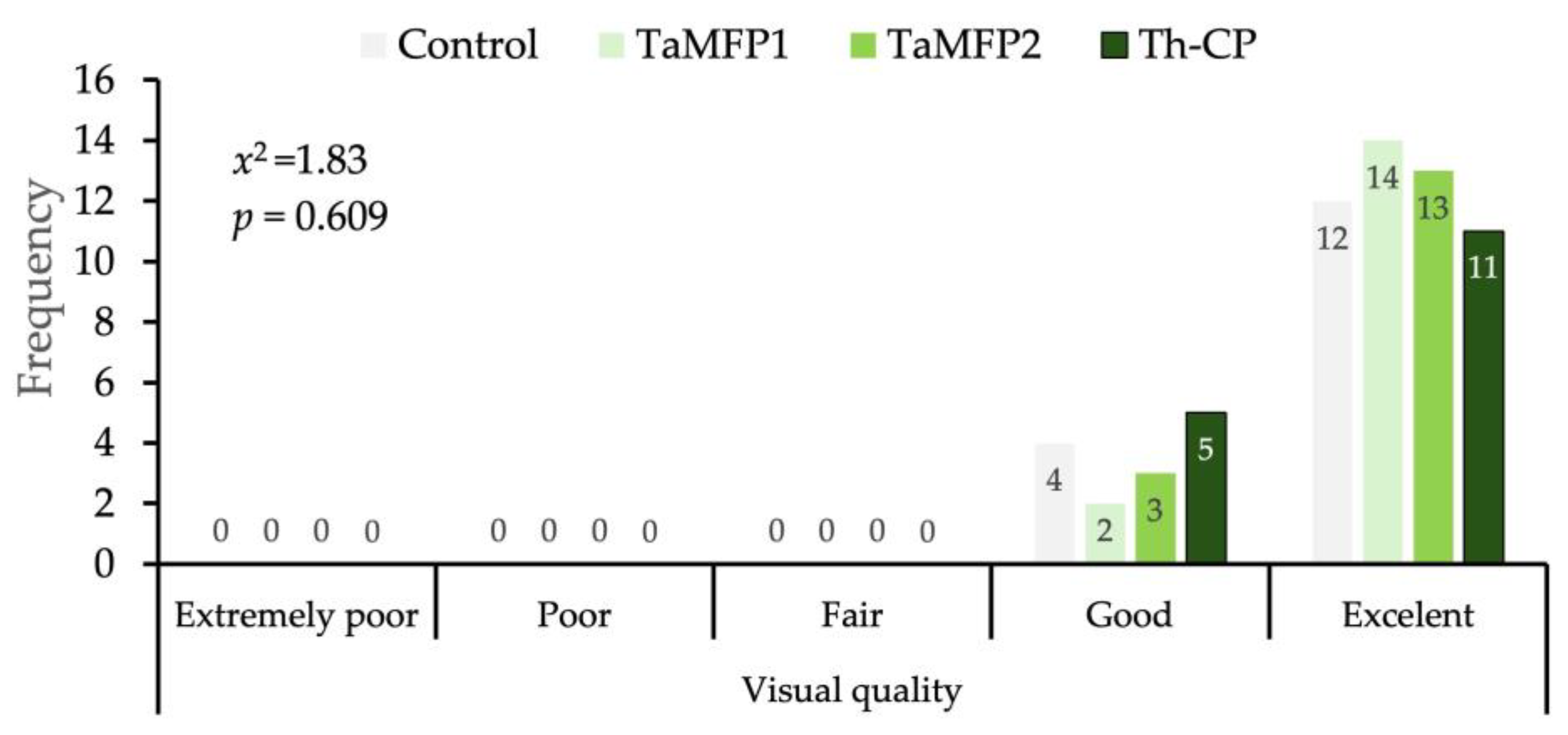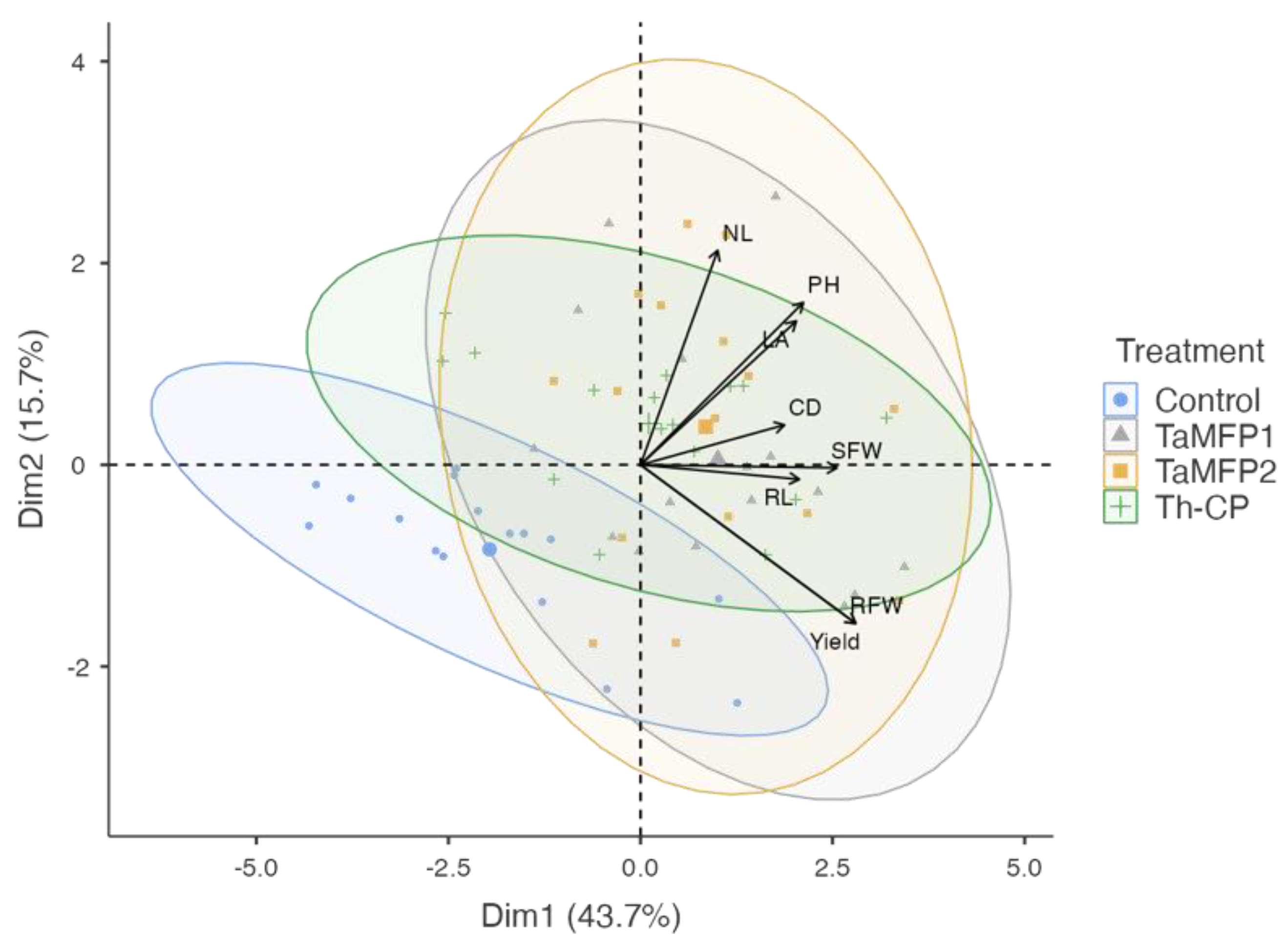Biostimulant Effects of Trichoderma asperellum in Hydroponic Spinach Production
Abstract
1. Introduction
2. Materials and Methods
2.1. Localization
2.2. Microorganisms
2.3. Preparation of Inoculum
2.4. Seedling Production
2.5. Trial Establishment
2.6. Plant Analysis
2.6.1. Morphological Parameters
2.6.2. Photosynthetic Pigments
2.6.3. Foliar Nutrient Content
2.7. Crop Yield
2.8. Visual Quality
2.9. Experimental Design
2.10. Statistical Analysis
3. Results
3.1. Trichoderma as a Growth Promoter of Spinach
3.2. Photosynthetic Pigments
3.3. Nutritional Content of Spinach
3.4. Yield of Spinach
3.5. Visual Quality of Spinach
3.6. Principal Component Analysis
4. Discussion
5. Conclusions
Author Contributions
Funding
Institutional Review Board Statement
Informed Consent Statement
Data Availability Statement
Conflicts of Interest
References
- Castiglione, A.M.; Mannino, G.; Contartese, V.; Bertea, C.M.; Ertani, A. Microbial Biostimulants as Response to Modern Agriculture Needs: Composition, Role and Application of These Innovative Products. Plants 2021, 10, 1533. [Google Scholar] [CrossRef] [PubMed]
- Hamid, B.; Zaman, M.; Farooq, S.; Fatima, S.; Sayyed, R.Z.; Baba, Z.A.; Sheikh, T.A.; Reddy, M.S.; El Enshasy, H.; Gafur, A.; et al. Bacterial Plant Biostimulants: A Sustainable Way towards Improving Growth, Productivity, and Health of Crops. Sustainability 2021, 13, 2856. [Google Scholar] [CrossRef]
- Sanjuán, J.; Nápoles, M.C.; Pérez-Mendoza, D.; Lorite, M.J.; Rodríguez-Navarro, D.N. Microbials for Agriculture: Why Do They Call Them Biostimulants When They Mean Probiotics? Microorganisms 2023, 11, 153. [Google Scholar] [CrossRef]
- Jiang, Y.; Yue, Y.; Wang, Z.; Lu, C.; Yin, Z.; Li, Y.; Ding, X. Plant Biostimulant as an Environmentally Friendly Alternative to Modern Agriculture. J. Agric. Food Chem. 2024, 72, 5107–5121. [Google Scholar] [CrossRef]
- Asghar, W.; Craven, K.D.; Kataoka, R.; Mahmood, A.; Asghar, N.; Raza, T.; Iftikhar, F. The application of Trichoderma spp., an old but new useful fungus, in sustainable soil health intensification: A comprehensive strategy for addressing challenges. Plant Stress 2024, 12, 100455. [Google Scholar] [CrossRef]
- Kubiak, A.; Wolna-Maruwka, A.; Pilarska, A.A.; Niewiadomska, A.; Piotrowska-Cyplik, A. Fungi of the Trichoderma Genus: Future Perspectives of Benefits in Sustainable Agriculture. Appl. Sci. 2023, 13, 6434. [Google Scholar] [CrossRef]
- Woo, S.L.; Hermosa, R.; Lorito, M.; Monte, E. Trichoderma: A multipurpose, plant-beneficial microorganism for eco-sustainable agriculture. Nat. Rev. Microbiol. 2023, 21, 312–326. [Google Scholar] [CrossRef] [PubMed]
- Prismantoro, D.; Akbari, S.I.; Permadi, N.; Dey, U.; Anhar, A.; Miranti, M.; Mispan, M.S.; Doni, F. The Multifaceted Roles of Trichoderma in Managing Rice Diseases for Enhanced Productivity and Sustainability. J. Agric. Food Res. 2024, 18, 101324. [Google Scholar] [CrossRef]
- Abdullah, N.S.; Doni, F.; Mispan, M.S.; Saiman, M.Z.; Yusuf, Y.M.; Oke, M.A.; Suhaimi, N.S.M. Harnessing Trichoderma in Agriculture for Productivity and Sustainability. Agronomy 2021, 11, 2559. [Google Scholar] [CrossRef]
- Guzmán-Guzmán, P.; Kumar, A.; de los Santos-Villalobos, S.; Parra-Cota, F.I.; Orozco-Mosqueda, M.d.C.; Fadiji, A.E.; Hyder, S.; Babalola, O.O.; Santoyo, G. Trichoderma Species: Our Best Fungal Allies in the Biocontrol of Plant Diseases—A Review. Plants 2023, 12, 432. [Google Scholar] [CrossRef]
- Nahidan, S.; Ahadi, N.; Abduolrahimi, S. Efficiency of some fungal species in phosphate solubilization and potassium and iron release from phlogopite and muscovite. Appl. Soil Res. 2023, 11, 112–124. [Google Scholar] [CrossRef]
- Promwee, A.; Intana, M. Trichoderma asperellum (NST-009): A potential native antagonistic fungus to control Cercospora leaf spot and promote the growth of ‘Green Oak’ lettuce (Lactuca sativa L.) cultivated in the commercial NFT hydroponic system. Plant Prot. Sci. 2022, 58, 139–149. [Google Scholar] [CrossRef]
- Charoenrak, P.; Chamswarng, C.; Intanoo, W.; Keawprasert, N. The effects of vermicompost mixed with Trichoderma asperellum on the growth and Pythium root rot of lettuces. Geomate J. 2019, 17, 215–221. [Google Scholar] [CrossRef]
- Gutiérrez-Chávez, A.; Robles-Hernández, L.; Guerrero, B.I.; González-Franco, A.C.; Medina-Pérez, G.; Acevedo-Barrera, A.A.; Hernández-Huerta, J. Potential of Trichoderma asperellum as a Growth Promoter in Hydroponic Lettuce Cultivated in a Floating-Root System. Plants 2025, 14, 382. [Google Scholar] [CrossRef]
- Pérez-Leal, R.; Rodríguez-Roque, M.J.; Acevedo-Barrera, A.A.; Villa-Martínez, A.; Guerrero, B.I.; Gutiérrez-Chávez, A.; Hernández-Huerta, J. Bacillus thuringiensis and Trichoderma asperellum as Biostimulants in Hydroponic Tendril Pea (Pisum sativum) Microgreens. Horticulturae 2025, 11, 39. [Google Scholar] [CrossRef]
- Yedidia, I.; Shoresh, M.; Kerem, Z.; Benhamou, N.; Kapulnik, Y.; Chet, I. Concomitant induction of systemic resistance to Pseudomonas syringae pv. lachrymans in cucumber by Trichoderma asperellum (T-203) and accumulation of phytoalexins. Appl. Environ. Microbiol. 2003, 69, 7343–7353. [Google Scholar] [CrossRef]
- Swain, A.; Chatterjee, S.; Viswanath, M.; Roy, A.; Biswas, A. Hydroponics in Vegetable Crops: A Review. Pharma Innov. J. 2021, 10, 629–634. Available online: http://www.thepharmajournal.com/ (accessed on 12 January 2025).
- Sela Saldinger, S.; Rodov, V.; Kenigsbuch, D.; Bar-Tal, A. Hydroponic Agriculture and Microbial Safety of Vegetables: Promises, Challenges, and Solutions. Horticulturae 2023, 9, 51. [Google Scholar] [CrossRef]
- Kannan, M.; Elavarasan, G.; Balamurugan, A.; Dhanusiya, B.; Freedon, D. Hydroponic farming—A state of art for the future agriculture. Mater. Today Proc. 2022, 68, 2163–2166. [Google Scholar] [CrossRef]
- Plocek, G.; Rueda Kunz, D.; Simpson, C. Impacts of Bacillus amyloliquefaciens and Trichoderma spp. on Pac Choi (Brassica rapa var. chinensis) grown in different hydroponic systems. Front. Plant Sci. 2024, 15, 1438038. [Google Scholar] [CrossRef]
- Nursyahid, A.; Setyawan, T.A.; Sa’diyah, K.; Wardihani, E.D.; Helmy, H.; Hasan, A. Analysis of Deep Water Culture (DWC) Hydroponic Nutrient Solution Level Control Systems. IOP Conf. Ser. Mater. Sci. Eng. 2021, 1108, 012032. [Google Scholar] [CrossRef]
- Hamza, A.; Abdelraouf, R.E.; Helmy, Y.I.; El-Sawy, S.M.M. Using deep water culture as one of the important hydroponic systems for saving water, mineral fertilizers and improving the productivity of lettuce crop. Int. J. Health Sci. 2022, 6, 2311–2331. [Google Scholar] [CrossRef]
- Suyantohadi, A.; Kyoren, T.; Hariadi, M.; Purnomo, M.H.; Morimoto, T. Effect of high consentrated dissolved oxygen on the plant growth in a deep hydroponic culture under a low temperature. IFAC Proc. Vol. 2010, 43, 251–255. [Google Scholar] [CrossRef]
- Ahmad, S.; Sehrish, A.K.; Ai, F.; Zong, X.; Alomrani, S.O.; Al-Ghanim, K.A.; Guo, H. Morphophysiological, biochemical, and nutrient response of spinach (Spinacia oleracea L.) by foliar CeO2 nanoparticles under elevated CO2. Sci. Rep. 2024, 14, 25361. [Google Scholar] [CrossRef] [PubMed]
- Ramaiyan, B.; Kour, J.; Nayik, G.A.; Anand, N.; Alam, M.S. Spinach (Spinacia oleracea L.). In Antioxidants in Vegetables and Nuts-Properties and Health Benefits; Ahmad, N.G., Gull, A., Eds.; Springer: Singapore, 2020; pp. 159–173. Available online: https://link.springer.com/book/10.1007%2F978-981-15-7470-2 (accessed on 12 January 2025).
- Syed, A.-U.-A.; Khan, Z.A.; Chattha, S.H.; Shaikh, I.A.; Ali, M.N.H.A.; Bughio, Z.-U.-R.; Dahri, S.H.; Buriro, G.B. Comparative Assessment of Hydroponic and Geoponic Cultivation Systems for Sustainable Spinach Cultivation. Pak. J. Agric. Res. 2021, 34, 678–688. [Google Scholar] [CrossRef]
- Chaparro, J.M.; Sheflin, A.M.; Manter, D.K.; Vivanco, J.M. Manipulating the soil microbiome to increase soil health and plant fertility. Biol. Fertil. Soils 2012, 48, 489–499. [Google Scholar] [CrossRef]
- De Corato, U. Soil microbiota manipulation and its role in suppressing soil-borne plant pathogens in organic farming systems under the light of microbiome-assisted strategies. Chem. Biol. Technol. Agric. 2020, 7, 17. [Google Scholar] [CrossRef]
- Lin, Y.P.; Lin, C.-M.; Mukhtar, H.; Lo, H.F.; Ko, M.C.; Wang, S.J. Temporal variability in the rhizosphere bacterial and fungal community structure in the melon crop grown in a closed hydroponic system. Agronomy 2021, 11, 719. [Google Scholar] [CrossRef]
- Setiawati, M.R.; Afrilandha, N.; Hindersah, R.; Suryatmana, P.; Fitriatin, B.N.; Kamaluddin, N.N. The Effect of Beneficial Microorganism as Biofertilizer Application in Hydroponic-Grown Tomato. SAINS TANAH—J. Soil Sci. Agroclimatol. 2023, 20, 66. [Google Scholar] [CrossRef]
- Gao, Y.; Zeng, X.D.; Ren, B.; Zeng, J.R.; Xu, T.; Yang, Y.Z.; Hu, X.C.; Zhu, Z.Y.; Shi, L.M.; Zhou, G.Y.; et al. Antagonistic activity against rice blast disease and elicitation of host-defence response capability of an endophytic Streptomyces albidoflavus OsiLf-2. Plant Pathol. 2019, 69, 259–271. [Google Scholar] [CrossRef]
- Dunn, B.; Singh, H. Electrical Conductivity and pH Guide for Hydropononics; Oklahoma State University Extension 2027, HLA-6722. Available online: https://acortar.link/06CXLo (accessed on 12 February 2024).
- Patrignani, A.; Ochsner, T.E. Canopeo: A powerful new tool for measuring fractional green canopy cover. Agron. J. 2015, 107, 2312–2320. [Google Scholar] [CrossRef]
- Ericsson, T. Growth and shoot: Root ratio of seedlings in relation to nutrient availability. In Nutrient Uptake and Cycling in Forest Ecosystems, Developments in Plant and Soil Sciences; Nilsson, L.O., Hüttl, R.F., Johansson, U.T., Eds.; Springer: Dordrecht, The Netherlands, 1995; Volume 62, pp. 205–214. [Google Scholar] [CrossRef]
- Parwada, C.; Chigiya, V.; Ngezimana, W.; Chipomho, J. Growth and performance of baby spinach (Spinacia oleracea L.) grown under different organic fertilizers. Int. J. Agron. 2020, 1, 8843906. [Google Scholar] [CrossRef]
- Fujita, S.; Noguchi, K.; Tange, T. Root Responses of Five Japanese Afforestation Species to Waterlogging. Forests 2020, 11, 552. [Google Scholar] [CrossRef]
- Lichtenthaler, H.; Wellburn, A.R. Determinations of Total Carotenoids and Chlorophylls a and b of Leaf Extracts in Different Solvents; Portland Press, Ltd.: London, UK, 1983. [Google Scholar] [CrossRef]
- Hernández, A.; Castillo, H.; Ojeda, D.; Arras, A.; López, J.; Sánchez, E. Effect of Vermicompost and Compost on Lettuce Production. Chilean J. Agric. Res. 2010, 70, 583–589. [Google Scholar] [CrossRef]
- Smith, M.W.; Cheary, B.; Carrol, B. Response of pecan to nitrogen rate and nitrogen application time. HortScience 2004, 39, 1412–1415. [Google Scholar] [CrossRef]
- Estefan, G.; Sommer, R.; Ryan, J. Methods of soil, plant, and water analysis. A Man. West Asia N. Afr. Reg. 2013, 3, 65–119. [Google Scholar]
- Moreira, V.D.A.; Oliveira, C.E.D.S.; Jalal, A.; Gato, I.M.B.; Oliveira, T.J.S.S.; Boleta, G.H.M.; Giolo, V.M.; Vitória, L.S.; Tamburi, K.V.; Filho, M.C.M.T. Inoculation with Trichoderma harzianum and Azospirillum brasilense increases nutrition and yield of hydroponic lettuce. Arch. Microbiol. 2022, 204, 440. [Google Scholar] [CrossRef]
- Bergquist, S.Å.; Gertsson, U.E.; Olsson, M.E. Influence of growth stage and postharvest storage on ascorbic acid and carotenoid content and visual quality of baby spinach (Spinacia oleracea L.). J. Sci. Food Agric. 2006, 86, 346–355. [Google Scholar] [CrossRef]
- García, M.; López, J.J.; Hidalgo, M.D. Análisis de datos categóricos. In En Métodos y Técnicas Avanzadas de Análisis de Datos en Ciencias del Comportamiento; Arnua, J., Ed.; Unitat de Barcelona: Barcelona, Spain, 1996; pp. 79–128. [Google Scholar]
- Tabachnick, B.G.; Fidell, L.S. Using Multivariate Statistics, 5th ed.; Pearson Education, Inc.: Boston, MA, USA, 2007; Available online: https://acortar.link/Ynt78M (accessed on 12 January 2025).
- Campbell, R.C. Reference Sufficiency Ranges for Plant Analysis in the Southern Region of the United States; Southern Cooperative Series Bulletin #394; North Carolina Department of Agriculture and Consumer Services Agronomic Division: Raleigh, NC, USA, 2009; p. 11.
- Pineda-Acosta, A.S.; Lara-Capistrán, L.; Hernández-Montiel, L.G.; Alafita-Vásquez, G.; Zulueta-Rodríguez, R. Efecto de microorganismos bioestimulantes en la morfometría de Lactuca sativa L. bajo un sistema hidropónico de raíz flotante. Rev. Int. Des. Reg. Sustentable 2021, 6, 27–37. Available online: https://acortar.link/N1SZFR (accessed on 12 January 2025).
- Leu, F.G.; Gilesky, N.; Petruzzi, L. Evaluación del efecto de Trichoderma atroviride cepa∝ cp8 y Bacillus velezensis en el cultivo de albahaca (Ocimum basilicum L.) en hidroponía en córdoba capital. Nexo Agropecu. 2023, 11, 46–53. [Google Scholar]
- Oliveira, C.E.d.S.; Jalal, A.; Oliveira, J.R.; Tamburi, K.V.; Teixeira Filho, M.C.M. Leaf Inoculation of Azospirillum brasilense and Trichoderma harzianum in Hydroponic Arugula Improve Productive Components and Plant Nutrition and Reduce Leaf Nitrate. Pesqui. Agropecu. Trop. 2022, 52, e72755. [Google Scholar] [CrossRef]
- Yedidia, I.; Srivastva, A.K.; Kapulnik, Y.; Chet, I. Effect of Trichoderma harzianum on microelement concentrations and increased growth of cucumber plants. Plant Soil 2001, 235, 235–242. [Google Scholar] [CrossRef]
- Shoresh, M.; Harman, G.E. The Molecular Basis of Shoot Responses of Maize Seedlings to Trichoderma harzianum T22 Inoculation of the Root: A Proteomic Approach. Plant Physiol. 2008, 147, 2147–2163. [Google Scholar] [CrossRef]
- Shoresh, M.; Harman, G.E. The Relationship Between Increased Growth and Resistance Induced in Plants by Root-Colonizing Microbes. Plant Signal. Behav. 2008, 3, 737–739. [Google Scholar] [CrossRef]
- Garnica-Vergara, A.; Barrera-Ortiz, S.; Muñoz-Parra, E.; Raya-Gonzalez, J.; Mendez-Bravo, A.; Macías-Rodríguez, L.; Ruiz-Herrera, L.F.; López-Bucio, J. The Volatile 6-Pentyl-2H-Pyran-2-One from Trichoderma atroviride Regulates Arabidopsis thaliana Root Morphogenesis via Auxin Signaling and ethylene insensitive 2 Functioning. New Phytol. 2015, 209, 1496–1512. [Google Scholar] [CrossRef]
- Vargas, W.A.; Mandawe, J.C.; Kenerley, C.M. Plant-Derived Sucrose Is a Key Element in the Symbiotic Association Between Trichoderma virens and Maize Plants. Plant Physiol. 2009, 151, 792–808. [Google Scholar] [CrossRef]
- Abdenaceur, R.; Farida, B.T.; Mourad, D.; Rima, H.; Zahia, O.; Fatma, S.H. Effective biofertilizer Trichoderma spp. isolates with enzymatic activity and metabolites enhancing plant growth. Int. Microbiol. 2022, 25, 817–829. [Google Scholar] [CrossRef] [PubMed]
- Kumar, K.; Thakur, P.; Rathore, U.S.; Kumar, S.; Mishra, R.K.; Amaresan, N.; Pandey, S.; Mishra, M. Plant beneficial effects of Trichoderma spp. suppressing Fusarium wilt and enhancing growth in Tomato. Vegetos 2022, 35, 188–195. [Google Scholar] [CrossRef]
- Andrade, P.; Rivera, M.N.; Landero, N.; Silva, H.V.; Martínez, S.J.; Romero, O. Beneficios ecológicos y biológicos del hongo cosmopolita Trichoderma spp. en la agricultura: Una perspectiva en el campo mexicano. Rev. Argent. Microbiol. 2023, 55, 366–377. [Google Scholar] [CrossRef]
- Caruso, G.; El-Nakhel, C.; Rouphael, Y.; Comite, E.; Lombardi, N.; Cuciniello, A.; Woo, S.L. Diplotaxis tenuifolia (L.) DC. Yield and Quality as Influenced by Cropping Season, Protein Hydrolysates, and Trichoderma Applications. Plants 2020, 9, 697. [Google Scholar] [CrossRef]
- Meng, X.; Miao, Y.; Liu, Q.; Ma, L.; Guo, K.; Liu, D.; Ran, W.; Shen, Q. TgSWO from Trichoderma guizhouense NJAU4742 promotes growth in cucumber plants by modifying the root morphology and the cell wall architecture. Microb. Cell Factories 2019, 18, 148. [Google Scholar] [CrossRef] [PubMed]
- Bononi, L.; Chiaramonte, J.B.; Pansa, C.C.; Moitinho, M.A.; Melo, I.S. Trichoderma spp. phosphorus-solubilizing strains from Amazonian soils enhance soybean plant growth. Sci. Rep. 2020, 10, 2858. Available online: https://goo.su/YjPxi (accessed on 12 January 2025). [CrossRef] [PubMed]
- Rouphael, Y.; Carillo, P.; Colla, G.; Fiorentino, N.; Sabatino, L.; El-Nakhel, C.; Giordano, M.; Pannico, A.; Cirillo, V.; Shabani, E.; et al. Appraisal of combined applications of Trichoderma virens and a biopolymer-based biostimulant on lettuce agronomical, physiological, and qualitative properties under variable n regimes. Agronomy 2020, 10, 196. [Google Scholar] [CrossRef]
- de Santiago, A.; Quintero, J.M.; Avilés, M.; Delgado, A. Effect of Trichoderma asperellum strain T34 on iron, copper, manganese, and zinc uptake by wheat grown on a calcareous medium. Plant Soil 2011, 342, 97–104. [Google Scholar] [CrossRef]
- Pereira, F.T.; Oliveira, J.B.D.; Muniz, P.H.P.; Peixoto, G.H.S.; Guimarães, R.R.; Carvalho, D.D.C. Growth promotion and productivity of lettuce using Trichoderma spp. commercial strains. Hortic. Bras. 2019, 37, 69–74. [Google Scholar] [CrossRef]




| Score | Description | Visual Quality |
|---|---|---|
| 9 | Defect-free, freshly harvested. | Excellent |
| 7 | Some leaves slightly yellowed or decayed or slight loss of turgor or some physical damage (<10%). | Good |
| 5 | Fair, moderately objectionable defects, limit of marketability. | Fair |
| 3 | Most leaves yellowed or decayed and considerable loss of turgor. | Poor |
| 1 | The product is entirely unfit for use, exhibiting complete chlorosis, mold growth, an unpleasant odor, excessive root development, and visible signs of physical deterioration. | Extremely poor |
| Parameters 1 | Treatments | |||
|---|---|---|---|---|
| Control | Th-CP | TaMFP1 | TaMFP2 | |
| Plant height (cm) | 25.11 ± 2.78 b | 31.73 ± 1.66 a | 30.46 ± 2.84 a | 30.54 ± 2.01 a |
| Collar diameter (cm) | 4.00 ± 0.057 b | 4.69 ± 0.75 a | 5.08 ± 0.70 a | 4.83 ± 0.58 a |
| Root length (cm) | 52.62 ± 7.55 b | 74.02 ± 14.25 a | 68.39 ± 19.01 a | 78.01 ± 1.74 a |
| Leaf area (cm2 plant−1) | 453.59 ± 84.71 b | 543.43 ± 94.04 a | 559.94 ± 64.14 a | 556.87 ± 121.71 a |
| Number of leaves (plant−1) | 13.13 ± 1.50 b | 14.00 ± 1.97 ab | 15.56 ± 2.00 a | 15.44 ± 2.78 a |
| Leaf area ratio (cm2 g−1) * | 261.02 ± 51.38 a | 248.63 ± 48.36 a | 260.98 ± 38.73 a | 248.96 ± 65.27 a |
| Specific root length (m g−1) ** | 2.85 ± 0.63 b | 3.27 ± 0.63 ab | 3.12 ± 1.27 ab | 3.79 ± 0.97 a |
| Parameters 1 | Treatments | |||
|---|---|---|---|---|
| Control | Th-CP | TaMFP1 | TaMFP2 | |
| Fresh biomass (g plant−1) | ||||
| Leaves | 24.54 ± 4.94 b | 28.00 ± 5.54 ab | 28.75 ± 4.01 ab | 31.64 ± 6.02 a |
| Root | 5.56 ± 1.60 b | 5.89 ± 1.54 b | 7.48 ± 1.52 a | 6.47 ± 1.22 ab |
| Total | 30.11 ± 6.23 b | 33.89 ± 6.66 ab | 36.23 ± 4.45 a | 38.11 ± 6.80 a |
| Dry biomass (g plant−1) | ||||
| Leaves | 1.57 ± 0.28 b | 2.00 ± 0.31 a | 1.93 ± 0.21 a | 2.07 ± 0.36 a |
| Root | 0.19 ± 0.3 b | 0.23 ± 0.05 ab | 0.24 ± 0.05 a | 0.21 ± 0.04 ab |
| Total | 1.76 ± 0.30 b | 2.22 ± 0.35 a | 2.16 ± 0.20 a | 2.28 ± 0.39 a |
| Shoot–root ratio (g g−1) | 8.41 ± 1.36 a | 8.81 ± 1.28 a | 8.70 ± 2.70 a | 9.86 ± 1.45 a |
| Parameters 1 | Treatments | |||
|---|---|---|---|---|
| Control | Th-CP | TaMFP1 | TaMFP2 | |
| Photosynthetic pigments (mg g−1 FW) | ||||
| Chlorophyll a ** | 1.25 ± 0.056 a | 1.26 ± 0.32 a | 1.26 ± 0.030 a | 1.23 ± 0.085 a |
| Chlorophyll b * | 0.75 ± 0.245 a | 0.60 ± 0.108 a | 0.54 ± 0.082 a | 0.57 ± 0.149 a |
| Carotenoids | 0.574 ± 0.080 a | 0.534 ± 0.040 a | 0.527 ± 0.58 a | 0.532 ± 0.057 a |
| Parameters 1 | Treatments | Sufficiency Range 2 | |||
|---|---|---|---|---|---|
| Control | Th-CP | TaMFP1 | TaMFP2 | ||
| Macronutrients (%) | |||||
| N * | 4.58 ± 0.31 b | 5.44 ± 0.37 a | 5.30 ± 0.54 ab | 4.50 ± 0.27 b | 4.0–6.0 |
| P | 1.12 ± 0.08 b | 1.20 ± 0.09 ab | 1.27 ± 0.04 a | 1.20 ± 0.07 ab | 0.3–0.5 |
| K | 4.31 ± 0.09 ab | 4.50 ± 0.13 a | 3.88 ± 0.15 c | 4.09 ± 0.23 bc | 3.0–8.0 |
| Ca | 1.35 ± 0.11 c | 1.79 ± 0.06 a | 1.60 ± 0.07 b | 1.54 ± 0.04 b | 1.0–1.5 |
| Mg | 1.64 ± 0.04 b | 1.72 ± 0.03 a | 1.69 ± 0.02 ab | 1.69 ± 0.01 ab | 0.4–1.0 |
| Micronutrients (ppm) | |||||
| Fe * | 102.75 ± 19.36 a | 93.13 ± 2.96 a | 90.25 ± 7.85 a | 82.63 ± 1.38 a | 50–200 |
| Mn * | 74.10 ± 9.78 a | 53.43 ± 5.84 bc | 41.55 ± 1.78 c | 56.23 ± 3.27 b | 25–200 |
| Cu * | 24.63 ± 2.32 a | 23.25 ± 2.22 ab | 21.00 ± 0.41 b | 20.00 ± 1.08 b | 5–15 |
| Zn | 32.63 ± 4.99 ab | 29.00 ± 5.28 b | 37.63 ± 4.32 ab | 41.35 ± 2.91 a | 20–75 |
Disclaimer/Publisher’s Note: The statements, opinions and data contained in all publications are solely those of the individual author(s) and contributor(s) and not of MDPI and/or the editor(s). MDPI and/or the editor(s) disclaim responsibility for any injury to people or property resulting from any ideas, methods, instructions or products referred to in the content. |
© 2025 by the authors. Licensee MDPI, Basel, Switzerland. This article is an open access article distributed under the terms and conditions of the Creative Commons Attribution (CC BY) license (https://creativecommons.org/licenses/by/4.0/).
Share and Cite
Hernández-Huerta, J.; Guerrero, B.I.; Acevedo-Barrera, A.A.; Balandrán-Valladares, M.I.; Yañez-Muñoz, R.M.; De Dios-Avila, N.; Gutiérrez-Chávez, A. Biostimulant Effects of Trichoderma asperellum in Hydroponic Spinach Production. Life 2025, 15, 428. https://doi.org/10.3390/life15030428
Hernández-Huerta J, Guerrero BI, Acevedo-Barrera AA, Balandrán-Valladares MI, Yañez-Muñoz RM, De Dios-Avila N, Gutiérrez-Chávez A. Biostimulant Effects of Trichoderma asperellum in Hydroponic Spinach Production. Life. 2025; 15(3):428. https://doi.org/10.3390/life15030428
Chicago/Turabian StyleHernández-Huerta, Jared, Brenda I. Guerrero, Angélica Anahí Acevedo-Barrera, Martha Irma Balandrán-Valladares, Rosa María Yañez-Muñoz, Ndahita De Dios-Avila, and Aldo Gutiérrez-Chávez. 2025. "Biostimulant Effects of Trichoderma asperellum in Hydroponic Spinach Production" Life 15, no. 3: 428. https://doi.org/10.3390/life15030428
APA StyleHernández-Huerta, J., Guerrero, B. I., Acevedo-Barrera, A. A., Balandrán-Valladares, M. I., Yañez-Muñoz, R. M., De Dios-Avila, N., & Gutiérrez-Chávez, A. (2025). Biostimulant Effects of Trichoderma asperellum in Hydroponic Spinach Production. Life, 15(3), 428. https://doi.org/10.3390/life15030428







